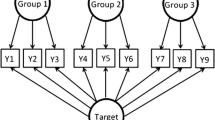Abstract
Multiple measures exist that examine the attentional aspects of meditation practice, but measurement of the compassion component is relatively understudied. This paper describes the development and initial validation of a scale designed to measure application of the four immeasurable qualities at the heart of Buddhist teachings: loving kindness, compassion, joy and acceptance toward both self and others. Our analyses suggest four distinct subscales: positive qualities toward self, positive qualities toward others, negative qualities toward self and negative qualities toward others. Initial examination of reliability and validity showed high internal consistency for the subscales as well as strong concurrent, discriminant, and construct validity. We believe the Self-Other Four Immeasurables (SOFI) scale has broad utility for research on mindfulness, positive psychology, and social psychology.

Similar content being viewed by others
References
Baer, R. A., Smith, G. T., & Allen, K. B. (2004). Assessment of mindfulness by self-report: The Kentucky inventory of mindfulness skills. Assessment, 11, 191–206. doi:10.1177/1073191104268029.
Baer, R. A., Smith, G. T., Hopkins, J., Krietemeyer, J., & Toney, L. (2006). Using self-report assessment methods to explore facets of mindfulness. Assessment, 13, 27–45. doi:10.1177/1073191105283504.
Brown, K. W., & Ryan, R. M. (2003). The benefits of being present: Mindfulness and its role in psychological well-being. Journal of Personality and Social Psychology, 84, 822–848. doi:10.1037/0022-3514.84.4.822.
Crowne, D. P., & Marlowe, D. (1960). A new scale of social desirability independent of psychopathology. Journal of Consulting Psychology, 24(4), 349–354. doi:10.1037/h0047358.
Davidson, R. J., Kabat-Zinn, J., Schumacher, J., Rosenkranz, M., Muller, D., Santorelli, S., et al. (2003). Alterations in brain and immune function produced by mindfulness meditation. Psychosomatic Medicine, 65, 564–570. doi:10.1097/01.PSY.0000077505.67574.E3.
Feldman, G., Hayes, A., Kumar, S., Greeson, J., & Laurenceau, J. P. (2007). Mindfulness and emotion regulation: The development and initial validation of the Cognitive and Affective Mindfulness Scale-Revised (CAMS-R). Journal of Psychopathology and Behavioral Assessment, 29(3), 177–190. doi:10.1007/s10862-006-9035-8.
Hayes, A. M., & Feldman, G. (2004). Clarifying the construct of mindfulness in the context of emotion regulation and the process of change in therapy. Clinical Psychology: Science and Practice, 11, 255–262. doi:10.1093/clipsy/bph080.
Jain, S., Shapiro, S. L., Swanick, S., Roesch, S. C., Mills, P. J., Bell, I., et al. (2007). A randomized controlled trial of mindfulness meditation versus relaxation training: Effects on distress, positive states of mind, rumination, and distraction. Annals of Behavioral Medicine, 33(1), 11–21. doi:10.1207/s15324796abm3301_2.
Kabat-Zinn, J. (1990). Full catastrophe living: Using the wisdom of your mind and body to face stress, pain, and illness. New York: Delacorte.
Kabat-Zinn, J., Lipworth, L., & Burney, R. (1985). The clinical use of mindfulness meditation for the self-regulation of chronic pain. Journal of Behavioral Medicine, 8(2), 163–190. doi:10.1007/BF00845519.
Kabat-Zinn, J., Wheeler, E., Light, T., Skillings, A., Scharf, M., Cropey, T., et al. (2003). Part II: Influence of a mindfulness meditation-based stress reduction intervention on rates of skin clearing in patients with moderate to severe psoriasis undergoing phototherapy (UVB) and photochemo-therapy (PUVA). Constructivism in the Human Sciences, 8(2), 85–106.
Lau, M. A., Bishop, S. R., Segal, Z. V., Buis, T., Anderson, N. D., Carlson, L., et al. (2006). The Toronto mindfulness scale: Development and validation. Journal of Clinical Psychology, 62(11), 1445–1467. doi:10.1002/jclp.20326.
Moffitt, P. (2008). Beyond happiness. Yoga Journal, (210), 107–108, 142.
Neff, K. D. (2003). The development and validation of a scale to measure self-compassion. Self and Identity, 2, 223–250. doi:10.1080/15298860309027.
Nhat Hahn, T. (1991). Old path white clouds: Walking in the footsteps of the Buddha. Berkeley, CA: Parallax Press.
Reynolds, W. M. (1982). Development of reliable and valid short forms of the Marlowe-Crowne Social Desirability Scale. Journal of Clinical Psychology, 38, 119–125. doi :10.1002/1097-4679(198201)38:1<119::AID-JCLP2270380118>3.0.CO;2-I
Ross, L. D., Amabile, T. M., & Steinmetz, J. T. (1977). Social roles, social control and biases in social-perception processes. Journal of Personality and Social Psychology, 35, 485–494. doi:10.1037/0022-3514.35.7.485.
Shapiro, S., Astin, J., Bishop, S., & Cordova, M. (2005). Mindfulness-based stress reduction for health care professionals: Results from a randomized trial. International Journal of Stress Management, 12(2), 164–176. doi:10.1037/1072-5245.12.2.164.
Shapiro, S. L., Brown, K. W., & Biegel, G. M. (2007). Teaching self-care to caregivers: Effects of mindfulness-based stress reduction on the mental health of therapists in training. Training and Education in Professional Psychology, 1, 105–115. doi:10.1037/1931-3918.1.2.105.
Teasdale, J. D., Segal, Z. V., Williams, J. M. G., Ridgeway, V. A., Soulsby, J. M., & Lau, M. A. (2000). Prevention of relapse/recurrence in major depression by mindfulness-based cognitive therapy. Journal of Consulting and Clinical Psychology, 68, 615–623. doi:10.1037/0022-006X.68.4.615.
Tedeschi, R. G., & Calhoun, L. G. (1996). The posttraumatic growth inventory: Measuring the positive legacy of trauma. Journal of Traumatic Stress, 9, 455–471.
Watson, D., Clark, L. A., & Tellegen, A. (1988). Development and validation of brief measures of positive and negative affect. Journal of Personality and Social Psychology, 54, 1063–1070. doi:10.1037/0022-3514.54.6.1063.
Author information
Authors and Affiliations
Corresponding author
Appendices
Appendices
Rights and permissions
About this article
Cite this article
Kraus, S., Sears, S. Measuring the Immeasurables: Development and Initial Validation of the Self-Other Four Immeasurables (SOFI) Scale Based on Buddhist Teachings on Loving Kindness, Compassion, Joy, and Equanimity. Soc Indic Res 92, 169–181 (2009). https://doi.org/10.1007/s11205-008-9300-1
Received:
Accepted:
Published:
Issue Date:
DOI: https://doi.org/10.1007/s11205-008-9300-1




